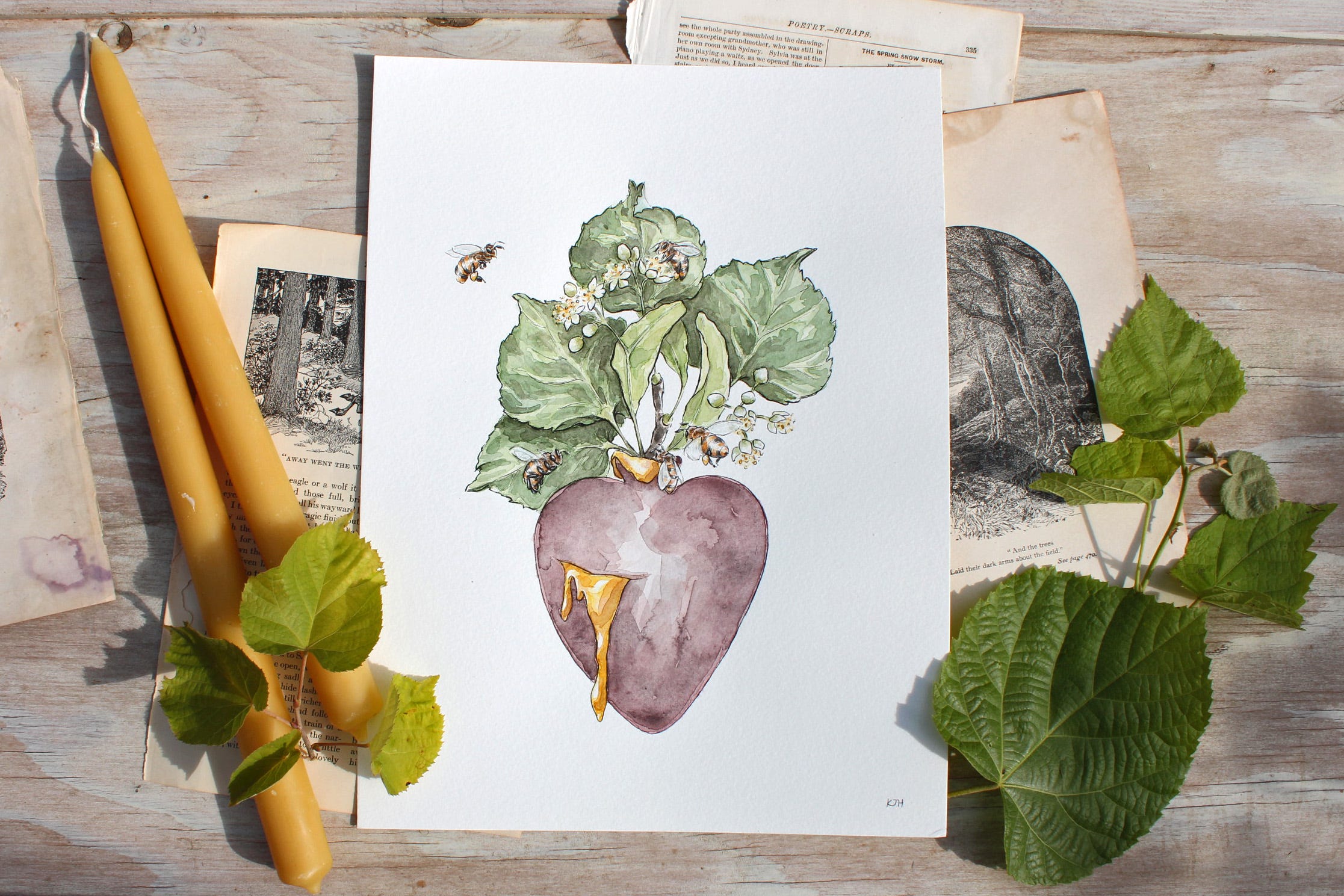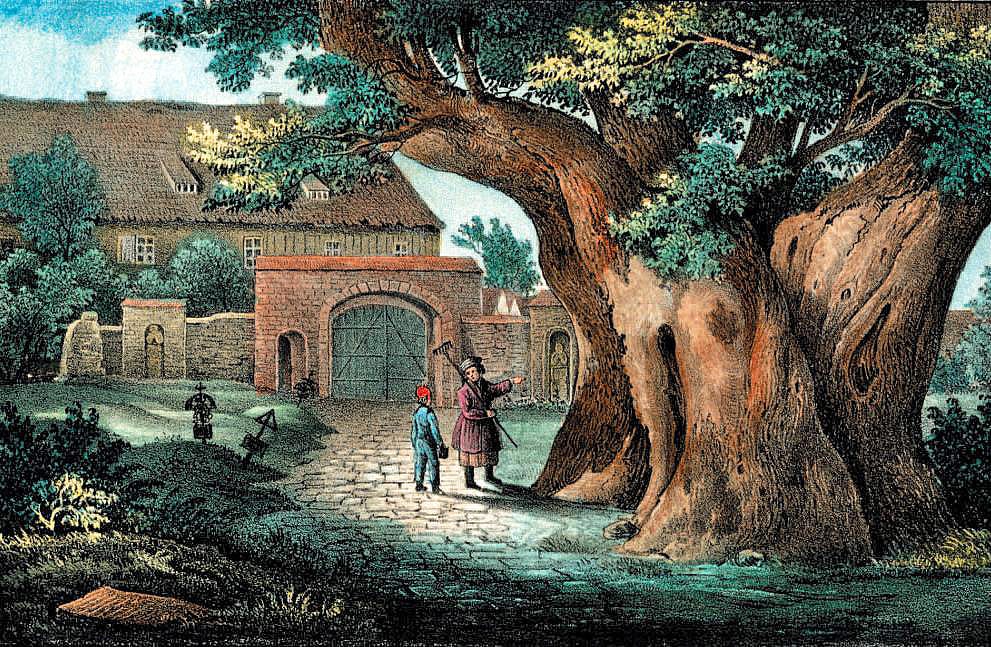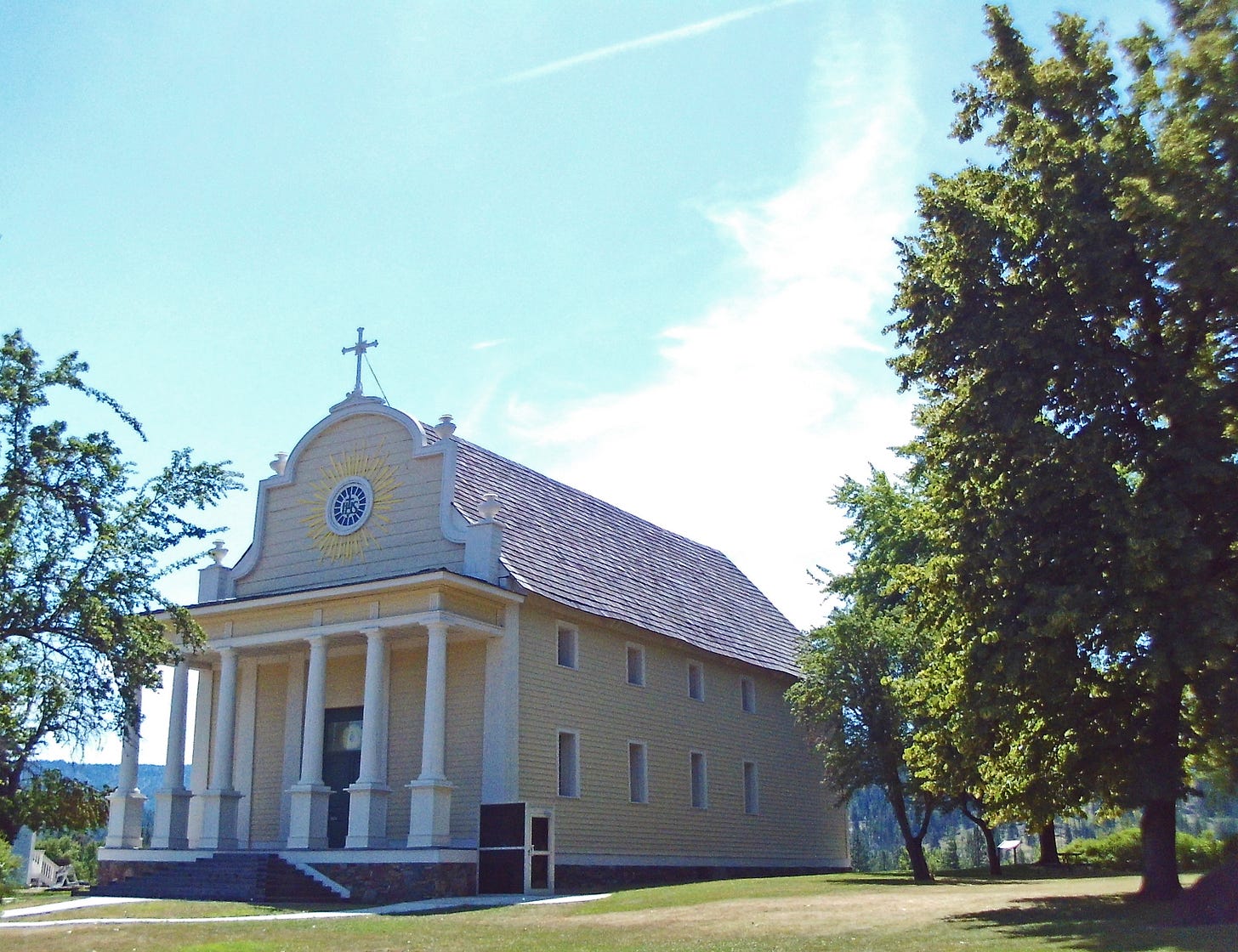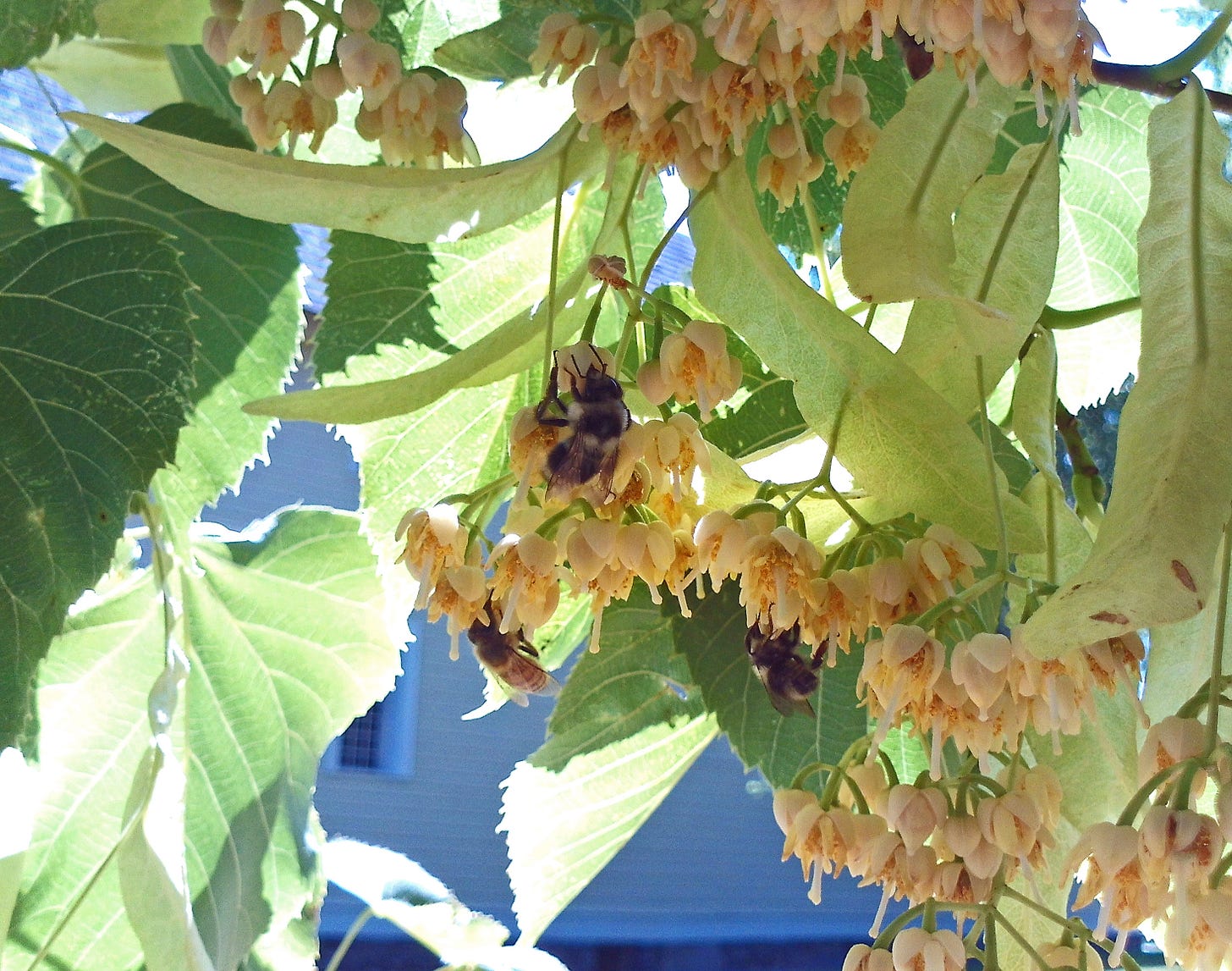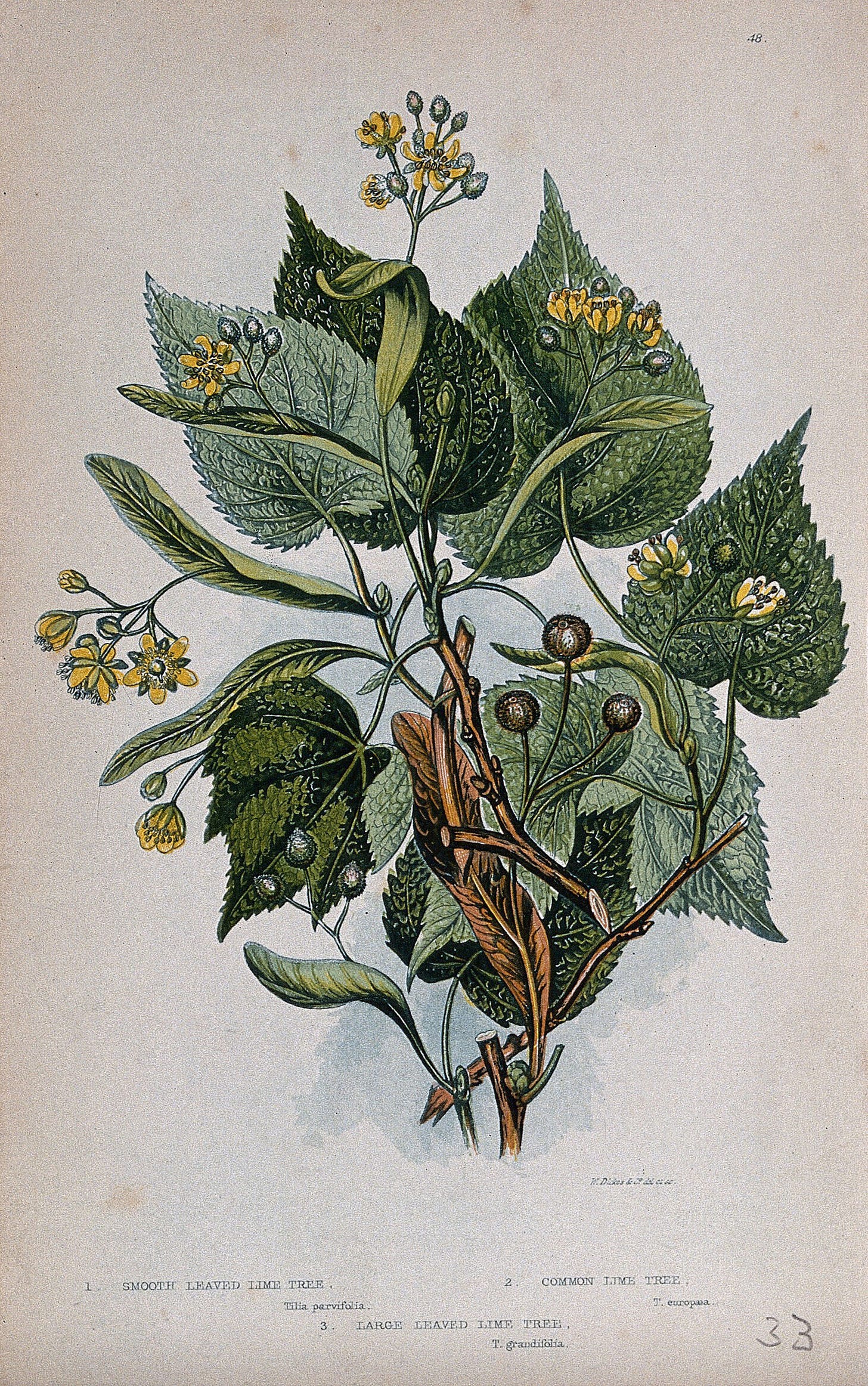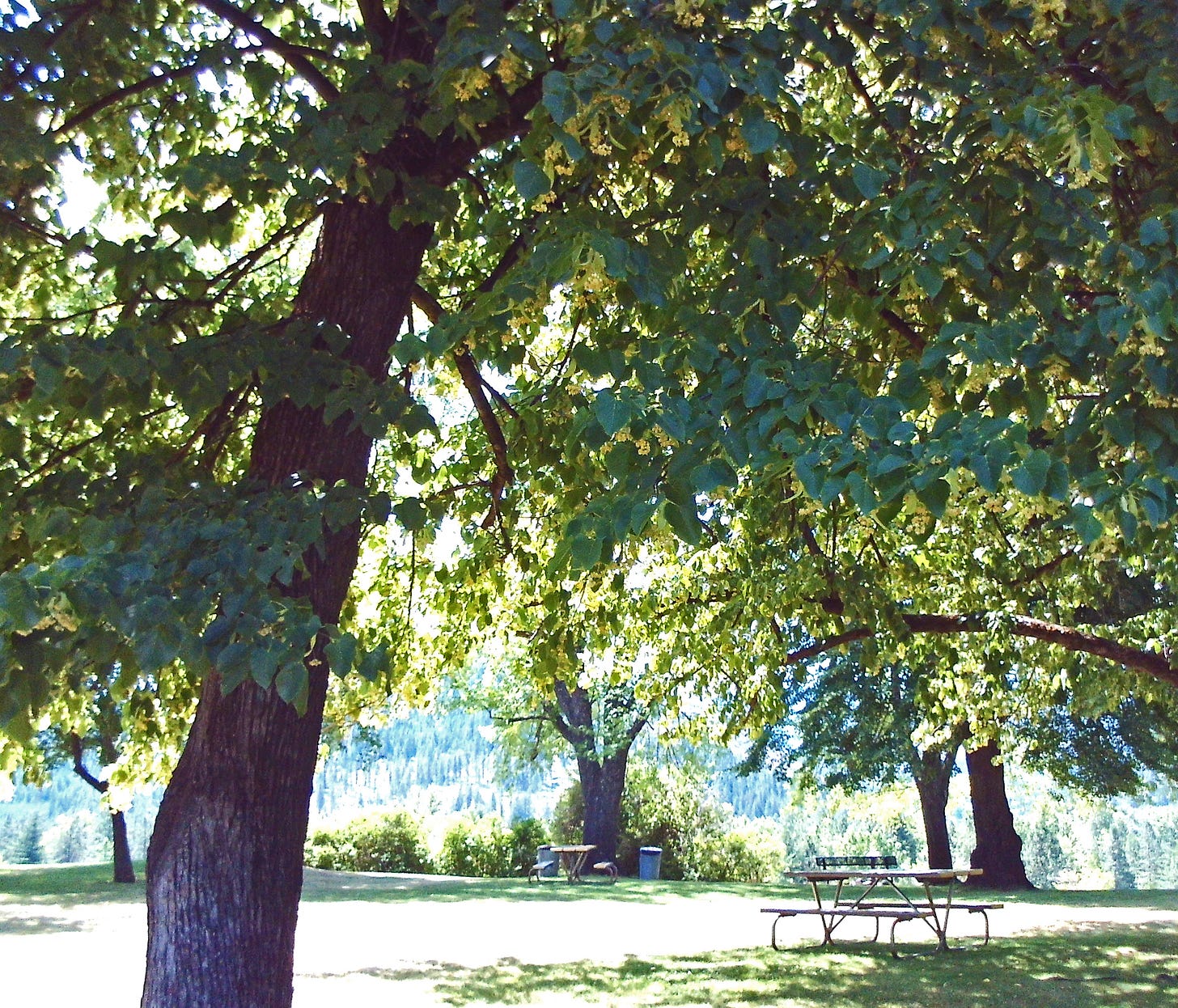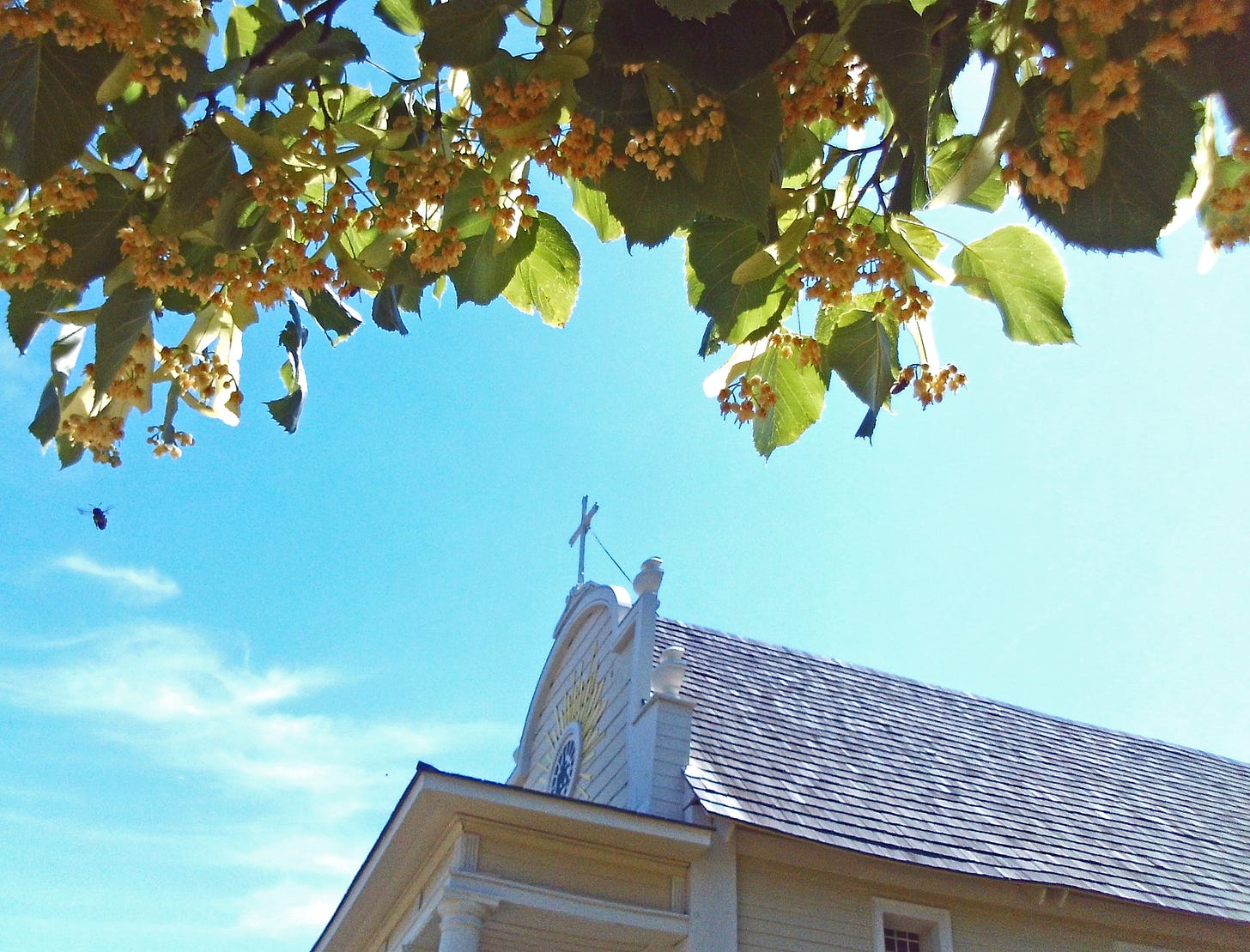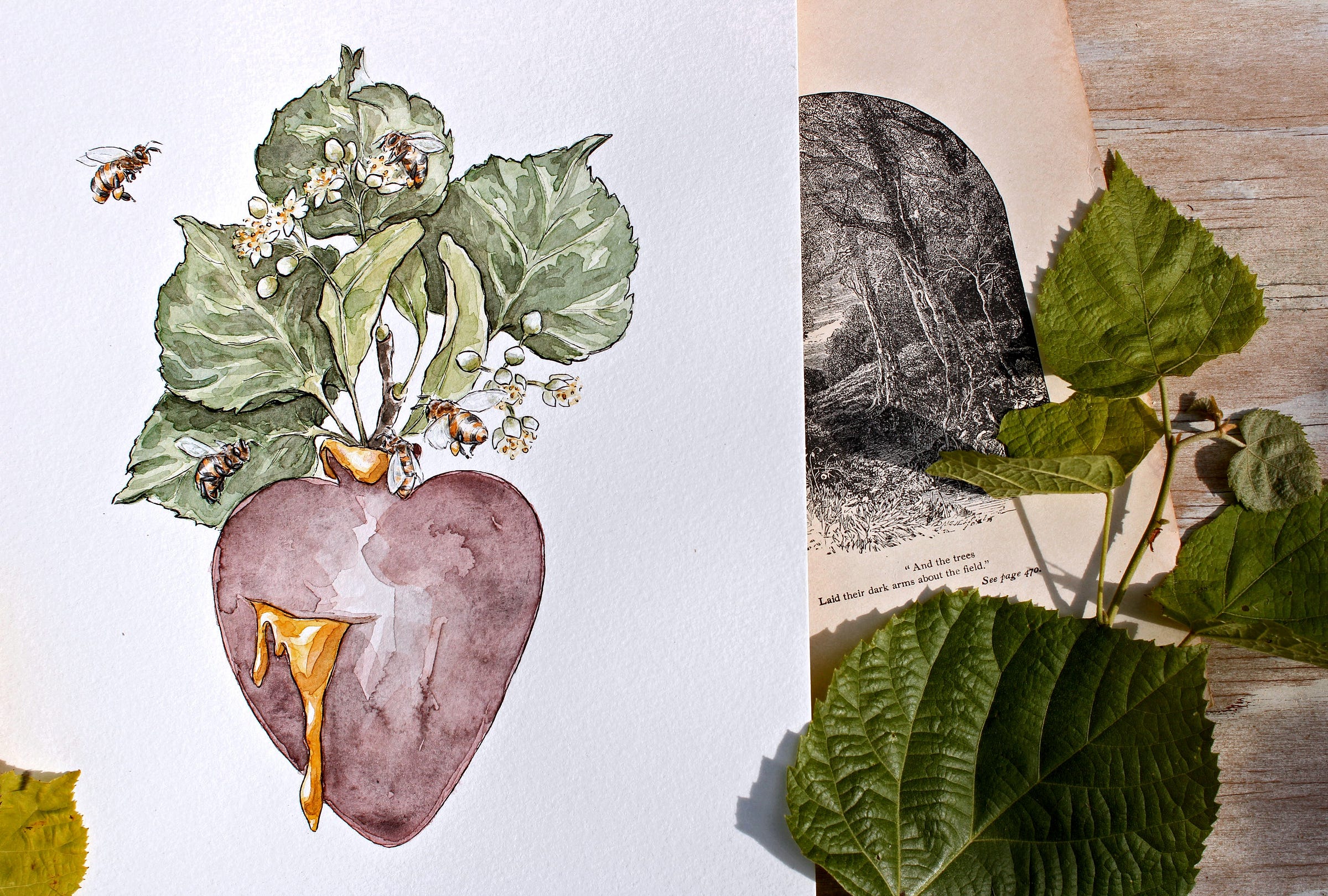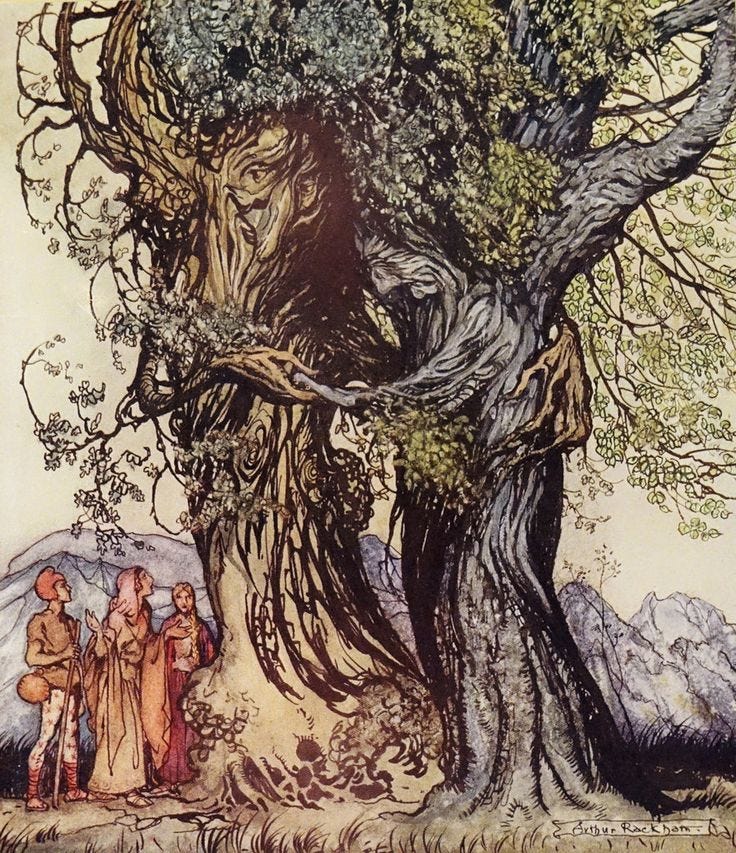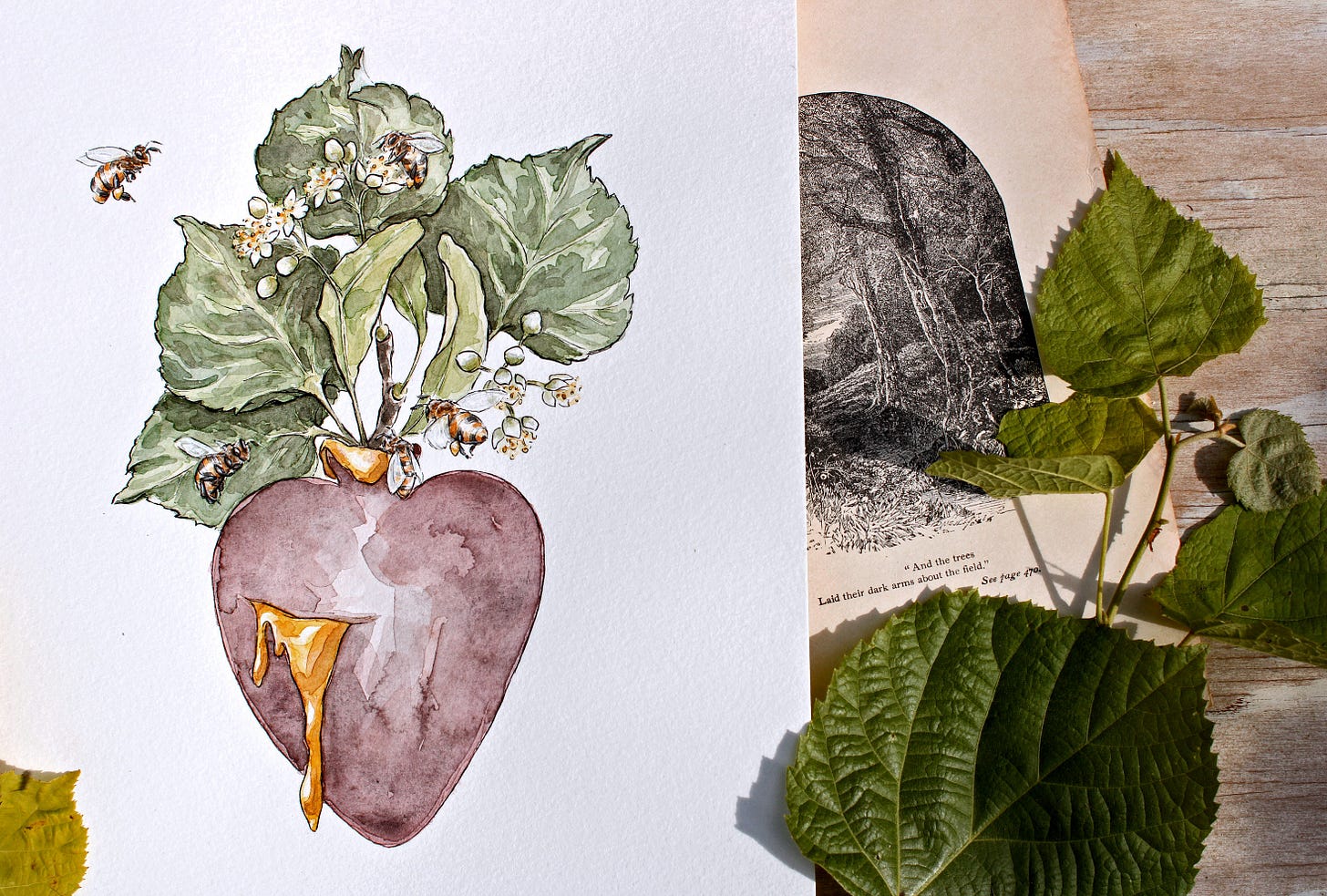Beneath the linden tree
Linden: A pilgrimage - and a new botanical liturgy series
That valley with its waving woods -
It’s waters flashing free -
The bank whereon our cottage stood,
Beneath the linden tree -
The wild flowers that in beauty there
Unfolded, in the summer air,
Their treasures to the bee -
All - all are ‘wakened by the spell
That lives in thee - sweet Sabbath bell!A church is there, with turret gray,
A venerable pile;
And ever on the Sabbath day,
We met within its aisle,
A mingled group and sweetly there
The song of praise - the voice of prayer -
Arose to heaven the while!
For young and old within that dell
Assembled with the Sabbath bell!Excerpt of “The Sabbath Bell” from Blackwood’s Lady’s Magazine and Gazette of the Fashionable World, Volumes 32-33 (1852)
Welcome to the first in a new series: Botanical Liturgies. In these posts, we’ll explore the devotional language that we can find in plants…the way nature wears our theology and faith tradition.
For more offerings, please visit the Village Green!
Pax+bonum, Kristin.
Sometimes we plan a pilgrimage - we head out on a journey with a labyrinthine intention to visit a sacred place, commemorate a sacred moment…to journey deeper into God’s call, setting aside time and space with that intention in mind.
And other times, the pilgrimage finds us. That was the theme of my summer.
SUMMER PILGRIMAGE
Ay, ‘tis they, dark linden trees,
Standing yonder, old and strong,
Ah, to come again to these
After pilgrimage so long!Goethe, Faust
This July, for a summertime visit with family and a meet-up with a friend1, I drove out from our corner of the Pacific Northwest and headed toward my home state of Montana. I caravanned with a dear childhood friend of mine, and we wanted to savor the journey, opting for small highways instead of big interstates, wandering through small-town main streets and roadside attractions along the way.
We visited charming country churches along these old highways,2 and once we were back on the main road, we decided to pull off the freeway at the Mission of the Sacred Heart (aka Cataldo Mission), just outside Coeur d’Alene, Idaho. I’ve driven past this mission countless times, always thinking we should stop there…but being so focused on the destination, that stop always got postponed.
The Mission is no longer an active church, instead being part of a larger state park (alongside its accompanying parish house and a visitor center). The Coeur d’Alene tribe, though, continues to use the Cataldo Mission grounds as a pilgrimage destination and a place of worship, coordinating beautiful events like their annual Solemnity of the Assumption pilgrimage and pow-wow.
We arrived at the Mission after it had closed…that ethereal golden hour in the middle of summer, when the sun is still low and bright through the trees well after dinnertime.3
Walking up the stairs to the porch of the closed church, I was overwhelmed - completely saturated by a (dare I say heavenly?) scent. And then I saw them…Linden trees, all in fragrant bloom and covered in bees.
I felt a bit like I had the wind knocked out of me.
In balmy May the Linden-tree puts on
Her citron vesture, delicately bright,
What time the poplar ceases to invite
All eyes to gaze on it, its fragrance gone;
And when the branches like a mighty fan
Wave to and fro, the pendant blossoms swell
Like blobs of honey dropping from the cell;
Look up, and count the clusters if ye can
And listen to the never-ending hum
Of honey-bees in myriads that come!
When frost-winged tempests howel in Hallow-tide,
A skeleton thou standest, Linden-tree;
Thy graceful foliage scattered far and wide;
Preaching to beauty a sad homily.Rev. James Cochrane of Cupor-Fife, “To the Linden-Tree” from Sonnets and Miscellaneous Poems (1853)
Before I was born, my parents planted a delicate Linden sapling in our front yard. It grew and grew, eventually towering over the house, and it was an entire world to me: I would play in its branches, create little fairy villages out of its seed pods, dust its pollen onto my skin. I’d watch in wonder as the Linden moved through the seasons, donning snow on bare branches in the winter, unfurling tender, bright green leaves in the late spring…
But, most of all, that linden was my mom’s beloved tree: she called it “Lindy”…pruning it, raking up debris, shaping it, caring for it. After my mother passed away (gosh…16 years ago now?), that tree became an ebenezer for me. A symbol of so many mysterious, sacred moments of pain and comfort all mixed together.
Over the past year, I’d felt really drawn to my memories of “Lindy”; so, in the spring, I ordered a few Linden saplings to plant out here in the PNW. More and more Linden trees kept showing up in my research - and, incredibly, I found that they were especially tied to the religious celebrations and symbolism from my Slovakian heritage.
When I stepped onto the Cataldo Mission’s porch, all of this came rushing to the fore: flooded with that scent of childhood, of comforting, beautiful memories of summer days with my family…as well as the hard memories of loss & grief. But, somehow, that grief wasn’t tinting the joy: from my perspective there on God’s front porch, I saw that the grief and joy were beautifully bound together.
The pilgrimage went on from there (with still more thin places to find) but, for now, I’m delighted to follow that cord of inspiration alongside you as we begin this new series of Botanical Liturgies.
IN HEAV’N A LINDEN TREE
There stood in heav’n a linden tree;
But, tho’ ‘twas honey laden,
All Angels cried, ‘No bloom shall be
Like that of one fair Maiden.’Excerpt from the hymn Es steht ein Lind im himelrich (ca. 1420), translated by George R. Woodward
Also called the Basswood or Lime Tree4, the Linden (genus Tilia) has long been a herald of love and fidelity.
In ancient Greek tradition, we find the story of Baucis and Philemon, so beautifully told through Ovid’s Metamorphoses5…an elderly married couple in a humble home, they offer their gracious hospitality to some mysterious guests.6 As it turns out, these guests are Zeus and Hermes, who grant a reward to their hosts: that they would die at the same time, and always remain together. Eventually, Baucis and her husband Philemon both began to sprout branches out of their heads, transforming into trees: Baucis into a Linden, and Philemon into an Oak, their branches intertwined.
This unusual love story is emblematic of the traditional ties, spanning cultures, of the Linden to faithful love: perhaps owing, in part, to its heart-shaped leaves, its fragrant blossoms, and its steadfastness & hardiness in harsh weather.
And the symbolism of the resilient, enduring Linden was grafted into the popular piety of Christian tradition - Linden’s heart-shaped leaves again reminiscent of faithful love, now transformed into a symbol of God’s devotion to humanity. Eventually, the Sacred Heart of Jesus would be transposed onto these iconic leaves, further solidifying that bond of symbol and meaning.
The Linden was often planted in town squares and churchyards, and its association with fidelity was deeply embedded in every aspect of culture, both civil and religious: a popular belief held that a person wouldn’t be able to be dishonest while standing under the Linden’s branches. Called judicum sub tilia, this ‘court under the lime tree’ was the canopy for settling so many inevitable disputes.
Under the Linden’s branches in the churchyard, fraught relationships were called forth into an honest & vulnerable discussion, relationships were tried and mended, communities worked imperfectly toward wholeness. Its hallowed role in village life extended beyond these outdoor spaces, with branches and flowers being brought inside churches or hung in homes as symbols of protection.



